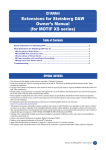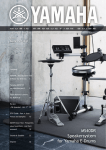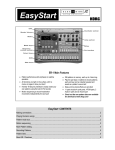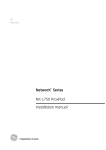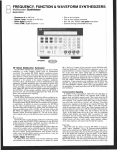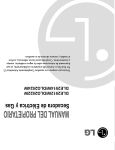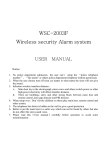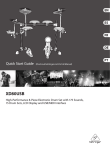Download Audiovox AXT240 Two-Way Radio User Manual
Transcript
Contents What is the Multi Part Editor?................................................... 2 About Studio Manager............................................................... 3 What is Total Recall? ................................................................ 3 Multi Part Editor Files ............................................................... 4 About Open Plug-in Technology ................................................ 5 Starting the Multi Part Editor ................................................... 6 An Example of the Multi Part Editor in Use.............................. 7 MIDI Port Settings When Using Remote Control Function .... 11 Menu Bar ................................................................................. 17 Window .................................................................................... 19 Toolbar..................................................................................... 20 Part Mixer Window .................................................................. 21 Dialogs..................................................................................... 30 Remote Operation ................................................................... 34 Troubleshooting....................................................................... 37 • • • • • • • Copying of the commercially available music sequence data and/or digital audio files is strictly prohibited except for your personal use. The software and this owner’s manual are exclusive copyrights of Yamaha Corporation. Copying of the software or reproduction of this manual in whole or in part by any means is expressly forbidden without the written consent of the manufacturer. Yamaha makes no representations or warranties with regard to the use of the software and documentation and cannot be held responsible for the results of the use of this manual and the software. The screen displays as illustrated in this Owner’s Manual are for instructional purposes, and may appear somewhat different from the screens which appear on your computer. The company names and product names in this Owner’s Manual are the trademarks or registered trademarks of their respective companies. Click on the red-colored text to jump to the related item in this manual. This owner’s manual assumes that you are already familiar with basic Windows/Macintosh operations. If you are not, please refer to the owner’s manual which came with your Windows/Macintosh software before using Multi Part Editor. For information about hardware requirements, the interconnection of devices and the installation of the Multi Part Editor software, refer to the separate InstallatIon Manual as well as the Owner’s Manual for the respective MIDI device. About Menu/Button Name When the name of the menu or button differs in Windows and Macintosh, the names are indicated as “Windows name (Macintosh name)” in the manual. © 2005 Yamaha Corporation. All rights reserved. 1 What is the Multi Part Editor? Multi Part Editor is a convenient way to edit and save the Multi parameters of your MOTIF-RACK. Thanks to its the easy-to-understand graphical interface, you can edit virtually all of the Multi parameters of the MOTIF-RACK right from your computer — using the mouse to adjust the virtual knobs, sliders, and buttons and entering values from the computer keyboard. Finally, all the changes you have made to your Multis can be saved to your computer. The Multi Part Editor can also be used in connection with devices such as the Yamaha 01X Digital Mixing Studio or MOTIF ES Music Production Sythesizer, allowing you to operate the Multi Part Editor using real hardware controls. You can use this Multi Part Editor as a plug-in for the software below. • Studio Manager • Sequencer compatible with Open Plug-in Technology (OPT). Select voices Select parameter Part Detail Window Select effects Chorus Reverb Common Detail Window Part Mixer Window Save data Remote operation Display information (parameter names / values) Transmit / Receive bulk data Transmit parameters 01X MOTIF-RACK MOTIF ES 6/7/8 2 About Studio Manager Studio Manager is a cross-platform application that enables you to start multiple Editors for controlling YAMAHA hardware products remotely, and to save multiple Editor settings. For more information, refer to the separate Installation Guide or the Studio Manager PDF manual. What is Total Recall? You can save and recall each Editor’s settings in Studio Manager. This enables you to recall all the settings of multiple devices from Studio Manager and control the entire system using simple operations. This capability is called the “Total Recall” function. Also, if you are saving the setup files or trying to synchronize multiple devices, you can recall all the settings for multiple devices using Studio Manager. Alternatively, you can recall the settings only for a certain device using the Editor of the corresponding device. For more information, refer to the Studio Manager PDF manual. Right-click the MOTIF-RACK Multi Part Editor icon in the Studio Manager window. Select “Configure Total Recall,” then select the data to be recalled. The data that can be selected differs depending on the Editor. The following data types can be selected in the MOTIF-RACK Multi Part Editor. • • • • • All.............................................. Multi, Normal User 1, 2, and Drum User Voice data Multi .......................................... Multi data Normal User 1 Voice ................. Normal User 1 Voice data Normal User 2 Voice ................. Normal User 2 Voice data Drum User Voice....................... Drum User Voice data (You can select multiple data simultaneously from the Multi, Normal User 1, 2, and Drum User Voices.) n When checking [From Hardware] from the [Synchronize] menu → [Total Recall], the Solo/Mute data will not be recalled. 3 Multi Part Editor Files Every Multi in the MOTIF-RACK can be made up of voices selected from the collection of User Voices stored in the MOTIF-RACK. When a voice is modified, each Multi that utilizes that voice will be modified as well and as a result, your Multis may not sound the way they did when you first made them. This is why Multi Part Editor files contain not only Multi data (pan, volume, effects and mixer settings, etc.) but User Voice data as well, ensuring that the voices which were used when the Multi was made can be saved and recalled. For example, let’s say you want to play a Multi, but you’ve edited or even overwritten some of the voices it uses. In this case, if you saved the Multi using Multi Part Editor, you can simply send the User Voice data from Multi Part Editor back to the MOTIF-RACK (page 32). The Multi will sound just as it did when you saved it. n When transmitting the User Voice data of the Multi Part Editor to the MOTIF-RACK, the User Voice data saved in the MOTIF-RACK will be lost. Makeup of Multi Part Editor Files (.M5E) Multi Data Each file contains Multi data and the User Voice data used by the Multi. User Voice Data • User1 (128) • User2 (128) • DrumUser (32) Makeup of Multi within MOTIF-RACK Multi Data 128 User Voice Data • User1 (128) • User2 (128) • DrumUser (32) Multi Data 1 All Multis share the same collection of User Voices. 4 About Open Plug-in Technology Open Plug-in Technology (OPT) is a new software format that enables you to control MIDI devices from a music DAW application software. For example, this allows you to start up and operate various parts of your music system, such as plug-in board editors, and mixing control editors directly from an OPT-compatible sequencer, without having to use each separately. OPT also makes it unnecessary to set MIDI drivers for each application, streamlining your music production system and making all operations more convenient and seamless. In addition to the original OPT, there is also Open Plug-in Technology Version 2 (OPT 2), designed for use with the Total Recall software. Studio Manager is a host application that supports OPT 2. About the OPT Levels and Overview The host application and its compatibility with OPT is divided into three levels, as shown below. Level 1 OPT Panels provides basic support for opening and displaying OPT control panels that can transmit data via the client’s external MIDI ports. Typically this will allow basic hardware editor control panels to operate properly. Level 2 OPT Processors provides support for real-time MIDI processors and panel automation. Typically this will allow both real-time and offline MIDI effects to operate properly and supply automation to OPT panels. Level 3 OPT Views provides support for edit views and MIDI processors/panels that require direct access to client program storage structures. Typically this will allow sophisticated MIDI edit views to be supported. Editor Host Application OPT-compatible plug-in software is connected directly to an OPT-compatible host application. OPT Editor Editor OPT Level Implementation for the MOTIF-RACK Multi Part Editor This chart shows the OPT-compatibility of the MOTIF-RACK Multi Part Editor. OPT levels of the host application MOTIF-RACK Multi Part Editor operation compatibility Operation support Operation limits VIEWS (Level 3) Yes None PROCESSORS (Level 2) Yes None PANELS (Level 1) Yes Bulk reception, remote control 5 All operations of the MOTIF-RACK Multi Part Editor can be utilized when running as a plug-in within Level 2 (Processors) and Level 3 (Views) host applications. Bulk data reception and remote control are not supported when running within Level 1 (Panels) host applications. n Certain operations may not work as expected if there is no corresponding function in the host application. The highest level of implementation for the host application is indicated by the OPT logo which appears along with the version information in the application. About the OPT 2 Overview OPT 2 is a plug-in format that enhances OPT Level 1 (Panels) and adds some convenient functions for use with Total Recall. In addition to doing Total Recall functions using the Studio Manager as a host application, you can use Total Recall in a DAW application (provided it is compatible with Total Recall), via the Studio Manager. Editor Host Application Studio Manager OPT2 Editor Plug-in software compatible with OPT 2 is indirectly connected to the DAW application compatible with Total Recall, via the Studio Manager. Editor Starting the Multi Part Editor After installing the Multi Part Editor and making the required connections, follow the instructions below to start the Multi Part Editor. ● Starting Multi Part Editor from Studio Manager 1. Start Studio Manager as a plug-in within DAW software compatible with Total Recall, or as a stand-alone application. 2. Start Multi Part Editor from Studio Manager. For more information, refer to the installation guide and Studio Manager PDF manual. ● Starting the Multi Part Editor in the sequencer software compatible with OPT as a plugin software. The Multi Part Editor can be used as a plug-in software in any host application compatible with Open Plug-in Technology (OPT). Refer to the owner’s manual of the host application (sequencer, etc.) for details on using plug-in software. n For OPT-compatible software, the Multi Part Editor settings will be saved along with the song file. 1. Start the host application. 2. Select “MOTIF-RACK Multi Part Editor” in the host application’s “Plug-in” menu. 6 An Example of the Multi Part Editor in Use There is no single way to use the many components of the Multi Part Editor. Your editing needs and preferences may differ; however, the following example gives you a simple step-by-step guide in how to use the Multi Part Editor. The Part Mixer window is the first window to open, so that’s where the explanation begins. n Before using the Multi Part Editor, you need to set the mode of the MOTIF-RACK to the Multi mode. 1. Click “Setup” under “Setup” in the menu bar to open the Setup dialog. Configure the parameters in this window to enable communication between Multi Part Editor and MOTIF-RACK. For further information, see page 31. n When using DAW software that is incompatible with OPT or Total Recall: When starting the Studio Manager as a stand-alone application and using it simultaneously with sequencer software, open the MIDI-USB Driver dialog and merge (join) the MIDI ports of the sequencer software with the MIDI ports of the Multi Part Editor (page 9). 2. Transfer the desired User Voices from the MOTIF-RACK (page 33) or open a Voice Editor file (page 17) with the Multi Part Editor. n Once User Voices are updated in the Multi Part Editor, they can be used the next time Multi Part Editor is started. If new voices are created or edited with the MOTIF-RACK or Voice Editor, the user voices must again be updated by transferring them from the MOTIF-RACK or opening a Voice Editor file. n If you don’t intend to use User Voices in the Multi, you can skip this step. 3. Transfer the desired Multi from the MOTIF-RACK into the Multi Part Editor. For more information, see “Receive Multi Bulk” on page 19. n If you intend to use a default Multi, you can skip this step. In this case, transmit the Multi (page 18) in order to synchronize the data in the Multi Part Editor and MOTIF-RACK. (1) Select the Multi data you want to send to the Multi Part Editor on the MOTIF-RACK. (2) Select “Receive Multi Bulk” under “Setup” in the menu bar. 4. Select a voice for each part. (1) Click on the voice name or bank name for each part to display the “Voice List”. (2) Select the voice you want to assign to the part. 5. Set parameters for each part in the Part Mixer window. Click the [DETAIL] button for each part and for the Common Section to make further settings. 6. Save your edited data by clicking the [Save] button in the toolbar. You can save a Multi for each of your songs. When you want to play a song, open the Multi Part Editor file (*.M5E) corresponding to the song. It will automatically be transmitted to the MOTIF-RACK. No further settings are necessary. Additionally, when running Multi Part Editor as a plug-in under a OPT-compatible host application such as SQ01, you can save your Multi Part Editor data as part of the host application’s song data. • • When starting the Multi Part Editor from the Studio Manager, you can save the Multi Part Editor data into the Session file of Studio Manager. When using DAW (digital audio workstation) software compatible with Total Recall and the Studio Manager together, the Multi Part Editor data will be saved into the Project file (Song file) of the DAW. 7 Notice when starting the Studio Manager as a stand-alone application When starting the Studio Manager as a stand-alone application, you’ll also need to have the sequencer running simultaneously so that you can check the Part or Voice sounds edited in the Multi Part Editor or Voice Editor by using an external keyboard. As shown in the example below, set the MIDI through function (echo setting) of the sequencer to direct the MIDI messages from an external keyboard to the MOTIF-RACK. Connection example MIDI Keyboard USB MIDI In Port 1-1 Computer Sequencer Studio Manager MIDI through (Echo setting) = on Multi Part Editor or Voice Editor USB MIDI Out Port 0-1 USB MIDI Out Port 0-2 USB MIDI In Port 0-1 Merge (join) Port 0-1 with Port 0-2 (page 9) MOTIF-RACK 8 Merging the MIDI inputs/outputs when using DAW software that is incompatible with OPT or Total Recall When starting the Studio Manager as a stand-alone application and using it simultaneously with sequencer software, open the MIDI-USB Driver dialog and merge (join) the MIDI ports of the sequencer software with the MIDI ports of the Multi Part Editor. (1) Display the “YAMAHA USB-MIDI Driver” dialog. Windows XP From the [Start] menu, select [Control Panels] → [MIDI-USB Driver]. Mac OS X From the Apple menu, select [System Preferences] → [YAMAHA USB-MIDI]. n The MIDI-USB Driver icon will not be displayed if MOTIF-RACK is not properly connected to the computer via USB, or if MOTIF-RACK is not turned on. n The “0” displayed in the port name (0-1, 0-2, etc.) indicates the number of the MIDI device connected to the computer via USB. Match this number to the “Device Name” in the “YAMAHA USB-MIDI Driver” dialog. 9 (2) In the “YAMAHA USB-MIDI Driver” dialog, merge the output ports. • OUT Change the settings to connect the two output ports which are used by the sequencer and Multi Part Editor to MOTIF-RACK input port 1. For example, change the settings as shown in the illustrations below when using the output port 1 and output port 2 in the Studio Manager (Multi Part Editor) and sequencer. OUT (3) Click [OK] to close the dialog. 10 MIDI Port Settings When Using Remote Control Function This chapter explains how to control the Multi Part Editor or DAW (sequencer) remotely using the 01X or MOTIF ES. Set the MIDI ports of your application software or your devices following the illustrations. n • When receiving bulk data with the Multi Part Editor, set “MIDI Thru” on your sequencer to off. • Configure the remote input and output ports of the Multi Part Editor (page 31). n When using DAW software that is incompatible with OPT or Total Recall: When starting the Studio Manager as a stand-alone application and using it simultaneously with sequencer software, open the MIDI-USB Driver dialog and merge (join) the MIDI ports of the sequencer software with the MIDI ports of the Multi Part Editor (page 9). 1. Remote-controlling using the MOTIF ES 1.1. MOTIF ES + Sequencer compatible with OPT (such as SQ01) + Multi Part Editor + MOTIF-RACK The ports can be changed. MOTIF ES6/7/8 USB Remote MIDI In/Out Port 1-4 (Mode A General) SQ01 Multi Part Editor Audio Mixer Track View USB MIDI In/Out Port 0-1 MOTIF-RACK 11 1.2. MOTIF ES + DAW compatible with Total Recall (such as Cubase SX 3) + Multi Part Editor + MOTIF-RACK The ports can be changed. MOTIF ES6/7/8 USB Remote MIDI In/Out Port 1-4 (Mode A Cubase) USB Remote MIDI In/Out Port 1-3 (Mode B General) Cubase SX 3 Audio Mixer Studio Manager Track View Multi Part Editor USB MIDI In/Out Port 0-1 MOTIF-RACK 12 1.3. MOTIF ES + DAW incompatible with OPT or Total Recall + Multi Part Editor + MOTIF-RACK The ports can be changed. MOTIF ES6/7/8 USB Remote MIDI In/Out Port 1-4 (Mode A Logic) USB Remote MIDI In/Out Port 1-3 (Mode B General) DAW Audio Mixer Studio Manager Track View Multi Part Editor USB MIDI In/Out Port 0-2 USB MIDI In/Out Port 0-1 USB MIDI In/Out Port 0-1 MOTIF-RACK 13 Merge (join) Port 0-1 with Port 0-2 (page 9) 2. Remote-controlling using the 01X 2.1. 01X + Sequencer compatible with OPT (such as SQ01) + Multi Part Editor + MOTIF-RACK The ports other than those assigned for 01X remote control can be changed. Controller: 01X mLAN Remote MIDI In/Out Port 1 SQ01 Multi Part Editor Audio Mixer Track View USB MIDI In/Out Port 0-1 MOTIF-RACK 14 2.2. 01X + DAW compatible with Total Recall (such as Cubase SX 3) + Multi Part Editor + MOTIF-RACK The ports other than those assigned for 01X remote control can be changed. Controller: 01X mLAN Remote MIDI In/Out Port 1 mLAN Remote MIDI In/Out Port 5 Cubase SX 3 Audio Mixer Studio Manager Multi Part Editor Track View USB MIDI In/Out Port 0-1 MOTIF-RACK 15 2.3. 01X + DAW incompatible with OPT or Total Recall + Multi Part Editor + MOTIF-RACK The ports other than those assigned for 01X remote control can be changed. Controller: 01X mLAN Remote MIDI In/Out Port 1 mLAN Remote MIDI In/Out Port 5 DAW Audio Mixer Studio Manager Multi Part Editor Track View USB MIDI In/Out Port 0-1 Merge (join) Port 0-1 with Port 0-2 (page 9) USB MIDI In/Out Port 0-2 USB MIDI In/Out Port 0-1 MOTIF-RACK 16 Menu Bar The Menu Bar contains various editing and setup functions/commands. Click the desired menu name to open the appropriate pull-down menu, and choose the function/command you wish to apply. Those functions/commands which are unavailable are grayed out. File New Creates and opens a default Multi. n User Voice settings in the MOTIF-RACK are not erased. Open Opens a Multi Part Editor file (page 30). Import Voice Opens Voice data files (*.W6E) Save Saves the current settings by overwriting the current file. Save As... Let you save the current Multi as a Multi Part Editor file under a new or different name (page 30). 17 Setup Setup... Allows you to specify the MIDI port numbers, device numbers, etc. (page 31). Transmit Multi Bulk Transmits the current Multi setting to the MOTIF-RACK below. Receive Multi Bulk Receives the current Multi setting from the MOTIF-RACK (page 19). Transmit Voice Bulk... Displays a dialog where you can select voice data to transmit to the MOTIF-RACK (page 32). Receive Voice Bulk... Displays a dialog where you can select voice data to receive from the MOTIF-RACK (page 33). “Transmitting bulk data” Display When transmitting the current Multi to the MOTIF-RACK, the progress bar shows how much of the data has been transmitted. 18 “Receive bulk data” Display Multi data can be received in bulk from the MOTIF-RACK. When receiving the current Multi from the MOTIF-RACK, the progress bar shows how much of the data has been received. n A time-out error message will be displayed when data cannot be received from the MOTIF-RACK (page 37). Window Close Closes the window selected in the Editor. Close All Closes all windows in the Editor. Part Mixer Opens the Part Mixer Window (page 21). Common Detail Opens the Common Detail Window (page 23). Part Detail Opens the Part Detail Window (page 27). 19 Toolbar 1 2 3 4 5 6 1 Open Opens a Multi Part Editor file (page 30). 2 Save Saves the current settings by overwriting the current file. 3 Editor Setup Allows you to specify the MIDI port numbers, device numbers, etc. (page 31). 4 Transmit Multi Bulk Transmits the current Multi setting to the MOTIF-RACK (page 18). 5 Receive Multi Bulk Receives the current Multi setting from the MOTIF-RACK above. 6 Part Mixer window Makes the Part Mixer Window active. 20 Part Mixer Window When you start Multi Part Editor, you will first see the Part Mixer Window, which consists of the common section and the part section. Here you can access most parameters of the Multi Part Editor. n For more information on each parameter, refer to Reference section on the Owner’s Manual. n • When using the MIDI echo (or “MIDI thru”) setting of the sequencer, the actual MIDI channel used for MIDI messages (transmitted from the keyboard to this synthesizer through the computer) will differ depending on the track selected in the sequencer. In other words, selecting a different track will automatically select a different MIDI channel. • To play the sound of the Part currently being edited, make sure to select the corresponding track on the sequencer. 6 7 8 1 9 0 A B C D 2 3 4 E F 5 Part Section Common Section Common Section 1 MASTER EQ Adjusts each parameter of the master equalizer. 2 REVERB Displays the current reverb type. Click to select a different reverb type. 3 CHORUS Displays the current chorus type. Click to select a different chorus type. 4 Master Volume Adjusts the overall volume of the mix. 5 DETAIL Click this to open the “Common Detail” window. Click on a tab to edit different parameters. For further details, see Common Detail Window (page 23). 21 Part Section (Part 1 – Part 16) 6 Part Number Displays the part number. 7 Voice Displays the Bank/Voice name selected for each part. Click this to open a Voice List dialog where you can select a voice. For further details, see the Voice List in the “Data List” booklet. 8 PART EQ (High/Mid/Low) Adjusts the equalizer settings for each part. 9 Insertion Effect Switch Switches the insertion effect on/off. n Insertion effects can be applied to up to four parts. 0 Reverb Send Adjusts the amount of signal sent to the reverb for each part. A Chorus Send Adjusts the amount of signal sent to the chorus for each part. B Mute Switches the mute on/off for each part. C Solo Switches the solo on/off for each part. D Pan Adjusts the pan of each part. E Part Volume Adjusts the volume of each part. F DETAIL Click this to open the “Part Detail” window for the selected part. Click on a tab to edit different parameters. For further details, see Part Detail Window (page 27). 22 Common Detail Window ARPEGGIO Tab Allows you to edit arpeggio parameters. REVERB Tab Allows you to edit reverb parameters. 23 CHORUS Tab Allows you to edit chorus parameters. MEQ Tab Allows you to edit the 5-band master equalizer parameters. 24 INS EFF SW Tab Switches the insertion effect for each part on/off. n Insertion effects can be applied to up to four parts. CTRL NUM Tab Allows you to assign MIDI control numbers to assignable controllers 1 & 2, foot controllers 1 & 2, and the breath controller parameters. 25 NAME Tab Allows you to assign a name to the Multi settings. 26 Part Detail Window GENERAL Tab Allows you to edit general parameters of the selected part. NOTE/VEL Tab Allows you to edit note limit and velocity parameters of the selected part. PITCH Tab Allows you to edit pitch parameters of the selected part. 27 AEG Tab Allows you to edit amplitude EG parameters of the selected part. FEG Tab Allows you to edit filter EG parameters of the selected part. PART EQ Tab Allows you to edit parameters of the 3-band equalizer for the selected part. 28 RCV SW Tab Allows you to edit receive switch parameters for the selected part. 29 Dialogs “Open” Dialog Select the desired Multi Part Editor file to open. n If you are using a Macintosh, the typical Macintosh “Open” dialog will appear. 1 2 3 4 5 6 1 Look in ............................ Pull-down menu choose the folder containing the desired Multi Part Editor or Voice Editor file. 2 List box............................ Shows the contents of the current folder. 3 File name ........................ Shows the name of the file selected from the list. 4 Files of type .................... Click this and choose the file type. *.M1E/*.M5E: MOTIF-RACK Multi Part Editor 5 Open ............................... Click this to open the file selected from the list. 6 Cancel............................. Click this to cancel the operation. “Save As” Dialog Name and save the current Multi settings in Multi Part Editor file (*.M5E) format. n Multi Part Editor files (*.M5E) consist of Multi data and user voice data. n If you are using a Macintosh, the typical Macintosh “Save As” dialog will appear. 1 2 3 4 5 6 1 Save in ............................ Pull-down menu choose the folder in which to save the file. 2 List box............................ Shows the contents of the current folder. 3 File name ........................ Specify the name of the Multi Part Editor file to be saved here. 4 Save as type ................... Click this and choose the file type. 5 Save................................ Click this to save the Multi Part Editor file with the name specified in the “File name” field. 6 Cancel............................. Click this to close the dialog without saving the file. 30 “Setup Dialog” Settings made here control how data is sent between the Multi Part Editor and the MOTIF-RACK or the 01X. (page 18) 1 2 3 4 5 6 7 8 9 1 MIDI In Remote Port ....... Click this and Select a remote MIDI input port. n When running Multi Part Editor as an SQ01 plug-in, the remote input port name set in the SQ01 will be displayed here. 2 MIDI Out Remote Port .... Click this and Select a remote MIDI output port. n When running Multi Part Editor as an SQ01 plug-in, the remote output port name set in the SQ01 will be displayed here. 3 MIDI In Port..................... Click this and Select a MIDI input port. Data from the MOTIF-RACK will be received on this port. 4 MIDI Out Port .................. Click this and Select a MIDI output port. Multi Part Editor will control the MOTIF-RACK by sending data on this port. 5 Device No........................ Required for transmitting/receiving system exclusive data (bulk data) to and from MOTIF-RACK. Set this to match the device number of the MOTIF-RACK. 6 Dump Interval ................. Sets the interval between packets of data when transmitting/receiving bulk data to the MOTIF-RACK. 7 Dial Mouse Control ......... Changes the operation of the parameter knobs. When “Rotate” is selected, the parameter values (of the panel “knobs”) are changed by clicking and dragging the mouse in a circular direction - in the same way as turning an actual knob. When “Up/Down or Left/Right” is selected, the parameter values (of the panel “knobs”) are changed by clicking and dragging the mouse vertically or horizontally - in the same way as operating a slider. n The setting made here affects all knobs. 8 OK................................... Click this to use the new settings and close the dialog. 9 Cancel............................. Click this to close the dialog without changing the settings. 31 “Transmit Dialog” Voice data can be transmitted in bulk to your synthesizer. Select the bulk voice data you wish to receive, then click [Start]. The progress bar shows how much of the data has been transmitted. Finally, click the [Close] button to quit the dialog. n When transmitting user voice data to the MOTIF-RACK, user voice data in the MOTIF-RACK will be overwritten. Exercise caution so as not to accidentally overwrite a User voice that you have used in another Multi configuration. n When the User Voice of any given part is already selected, transmit the Multi settings to the MOTIFRACK after you bulk transmit the User Voice data. By transmitting the Multi settings you can play the MOTIF-RACK the newly transmitted voice data. n Transmission time can be set under “Dump Interval” on the “Setup dialog” (page 31). 1 2 3 4 1 Transmit Type .................. Click this and select which user voice data to transmit to the MOTIFRACK. Normal User 1+2+Drum ......... All Normal User 1, 2 voices and Drum voices Normal User 1 ........................ All Normal User 1 voices Normal User 2 ........................ All Normal User 2 voices Normal User 1+2 .................... All Normal User 1, 2 voices Drum User .............................. All Drum User voices n Voice data for optional plug-in boards can not be transmitted. 2 Progress Bar ................... Indicates how much of the data has been transmitted. 3 Start ................................ Click this to begin the transmission. Once transmission has started, this button changes to a [Stop] button. Clicking [Stop] will stop the transmission. 4 Close............................... Click this to close this dialog. n The MIDI Device Number has to be set correctly in order to transmit bulk data. For further details, see page 31. 32 “Receive Dialog” Voice data can be received in bulk from your synthesizer. Select the bulk voice data you wish to receive, then click [Start]. The progress bar shows how much of the data has been received. Finally, click the [Close] button to quit the dialog. n User voices cannot be edited in the Multi Part Editor. You can edit user voices using the MOTIF-RACK itself or the Voice Editor software. 1 2 3 4 1 Receive Type................... Click this and select which user voice data to receive from the MOTIFRACK 6/7/8. Normal User 1+2+Drum ......... All Normal User 1, 2 voices and Drum voices Normal User 1 ........................ All Normal User 1 voices Normal User 2 ........................ All Normal User 2 voices Normal User 1+2 .................... All Normal User 1, 2 voices Drum User .............................. All Drum User voices n Voice data for optional plug-in boards can not be received. 2 Progress Bar ................... Indicates how much of the data has been transmitted. 3 Start ................................ Click this to begin the reception. Once reception has started, this button changes to a [Stop] button. Clicking [Stop] will stop the reception. 4 Close............................... Click this to close this dialog. 33 Remote Operation The Multi Part Editor can be operated remotely by a hardware controller, such as the Yamaha Digital Mixing Studio 01X. Below is an example of remote operation using the 01X, when the Multi Part Editor is running as a plug-in under SQ01. After configuring the remote MIDI port settings, press [REMOTE] then [MIDI] on the 01X to start the Multi Part Editor. When starting the Multi Part Editor from the Studio Manager, press [SHIFT]+[REMOTE] to start the Multi Part Editor. n Set the appropriate ports required for remote operation beforehand (page 11, 31). Edit mode & NAME Part Detail Window Mixing mode & NAME Common Detail Window Part Mixer Window Remote Remote Parameter category Part EQ EQL-F EQL-G EQH-F EQH-G Part being edited EQM-F EQM-G Part name SEL<Part3> EQM-Q Part1 Pan Part2 Pan Part3 Pan Part4 Pan Part5 Pan Part6 Pan Edit mode & VALUE Mixing mode & VALUE Parameter name Parameter name EQL-G 0.0 EQH-F 10.0 EQH-G 0.0 EQM-F 1.1 EQM-G 0.0 EQM-Q PEAK Pan L63 R63 L63 R63 CTR CTR CTR Parameter value Parameter value Remote Part Detail Window Part8 Pan Parameter name Parameter name EQL-F 125 Part7 Pan Remote Common Detail Window Part Mixer Window 34 CTR Operating the Multi Part Editor remotely from the 01X The MOTIF ES can also be used as a controller for Multi Part Editor functions. For details on operations of the MOTIF ES, refer to the MOTIF ES Owner’s Manual. n Each channel on the 01X controls are corresponding to each part in the Multi Part Editor. Basic Operation (common to both modes, Mixing and Edit) 01X operation (buttons) Explanation for remote control operation [REMOTE] ➜ [MIDI] When running as a plug-in under SQ01, initiates remote operation of the Multi Part Editor. [SHIFT] + [REMOTE] When starting the Multi Part Editor from the Studio Manager, initiates remote operation of the Multi Part Editor. [NAME/VALUE] Switches the Name/Value mode displayed on the 01X. BANK Switches the 1-8 channels to 1-8 parts. BANK Switches the 1-8 channels to 9-16 parts. [SELECTED CHANNEL] Switches the Mixing mode and Edit mode. Rotating a channel knob Adjusts the selected parameter. Pushing a channel knob Switches the selected parameter on/off when it is an “on/off” type parameter. [SHIFT] + rotating a channel knob Adjusts the selected parameter in large increments (ten times). [SHIFT] + pushing a channel knob Returns the selected parameter to its default value. Operation in the Mixing mode Faders Controls the volume of the selected part and the master volume. [ON] When [SOLO] button is lit, switches SOLO on/off for the selected part. When [SOLO] button is not lit, switches the selected part on/off. Selecting parameter controlled with a channel knob. DISPLAY Selects a parameter one by one. [PAGE SHIFT] + DISPLAY Selects the parameters to be edited section. [PAN] Enables control over Pan. [SEND] Enables control over Reverb Send level. [GROUP] Enables control over the voice for the selected part. [EFFECT] Enables on/off control over the Insertion Effect. [SEL] (Master) Enables control over Master EQ. EQ [LOW] Enables control over EQ Low for the selected part. EQ [LOW-MID] or [HIGH-MID] Enables control over EQ Mid for the selected part. EQ [HIGH] Enables control over EQ High for the selected part. 35 Operation in the Edit mode [SEL] (CH1-16) Displays the corresponding Part Detail window. [SEL] (Master) Displays the Common Detail window. Selecting parameter controlled with a channel knob. [PAGE SHIFT] + DISPLAY Switches tabs. DISPLAY Switches rows. Knobs (CH1-8) Edit parameters from left to right (Ch1, Ch2, Ch3…) corresponding to each knob. For example, to edit the third parameter from the left shown on the screen, use the Ch 3 knob. 36 Troubleshooting If you encounter problems such as no sound output or abnormal behavior, verify the connections before checking the following. Sound does not change when using the knobs or sliders. • Are the MIDI Out port and Device Number set correctly in the “Setup dialog”? (page 31) Bulk data is not transmitted. • Are the MIDI Out port and Device Number set correctly in the “Setup dialog”? (page 31) • Is the Dump Interval in the “Setup dialog” too short? Make sure to adjust the Dump Interval. Bulk data is not received. Time-out errors are frequent. • Are the MIDI Out port and Device number set correctly in the “Setup dialog”? (page 31) • Depending on the host application, you may need to turn MIDI Thru setting off in the host application. • When running the Multi Part Editor as an SQ01 plug-in, reduce the buffer size in SQ01 under [Setup] menu → [MIDI] → [System Exclusive] → Receive Buffer Size. The MIDI In/Out port is not available in the “Setup dialog”. • Only MIDI Ports selected in the host applications MIDI Setup can be selected in the “Setup dialog”. Confirm the ports selected in the host application. Remote operation functions don’t work. • Is the remote output port set correctly in the “Setup dialog”? (page 31) • Is the remote operation device configured correctly? When using the 01X as a remote operation device, make sure the REMOTE and MIDI buttons are on. Parts using User Voices do not sound correctly. • Has the User Voice data been transmitted to the MOTIF-RACK? (page 32) By transmitting the Multi settings, you can play the MOTIF-RACK with the newly transmitted voice data. Noise is audible during remote operation For Windows XP users: • The condition may improve if you enable Hyper-Threading in the BIOS settings. For information on how to enable Hyper-Threading, refer to the owner’s manual of your computer. 37





































